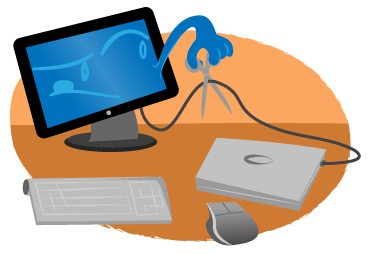-
-
products
-
resources
-
support
-
company
-
Illustration: Gordon McAlpin Let’s face it: Wires cause clutter. The more wires you have from your laptop or desktop PC to your peripherals, the more clutter there is, and the more wires can get tangled, pulled out, frayed or ruined. And then you’d need to call an IT service company like LG Networks for a resolution. Thankfully, electronics are moving in a wireless direction. Fewer cords is a good thing, right? Sure, but not always.
First, let’s talk about the three different (and popular) types of Wireless technology found in PCs today and I’ll discuss the pros and cons of each.
1. Radio frequency (RF) Wireless
These devices are based on older technology, and broadcast their signal over radio waves. These sorts of wireless bands can give and recieve interference from various things such as speakers, microwaves, Wi-Fi, and so on. The upside is that range is huge: 40 feet or more.Since no PC has a RF transmitter built in, RF wireless devices require a dongle, or small USB device plugged in to an available port. The peripheral itself (often PC headphones) will sometimes need batteries, or have a built-in battery that needs charged frequently and can’t be replaced.
The freedom that wireless headphones provide, in particular, can’t be underestimated. Nothing like pulling a laptop off a table because you didn’t realize your headset cord wouldn’t stretch that far.
Other PC devices that commonly use RF are “presenters”, or remote controls / laser pointers that control PowerPoint; game control pads; keyboards, and mice.
2. Bluetooth Wireless
Bluetooth is a newer technology, and though it also uses radio frequency, it’s a much shorter wavelength, meaning interference is much less likely.The disadvantage of Bluetooth is the device range is much shorter. Effective range of the Bluetooth standard is 32 feet, but you’ll find devices failing to work at much shorter distances.
The advantage of Bluetooth is that almost all modern laptops and mobile devices come with Bluetooth built-in, making a dongle unnecessary. Also, one Bluetooth antenna on a PC can pair with multiple devices, which RF can’t do.
Typical Bluetooth devices are headsets and earpieces; keyboards, and mice. These devices will likely need batteries, and Bluetooth can drain them quickly.
3. Wi-Fi
Some devices, such as printers, can connect to a PC through a Wi-Fi network rather than a USB cord.This has the advantage of setting up a printer on a network easily; locating the printer elsewhere in the house from the PC; and even printing from a mobile device, such as a phone.
The disadvantage is that the Wi-Fi printer is going to be sharing Internet with many other devices in your home, potentially causing slowness.
Usually, a Wi-Fi device will be your printer or scanner, or a hard drive. Also, it’s worth pointing out that cell phones are moving away from USB activation, sync and updates and toward Wi-Fi, meaning you may never need to plug your phone into a PC. Finally, Wi-Fi hard drives will have trouble streaming high-definition content compared to their wired cousins.
The App Problem
Regardless of what wireless device you choose, you will need a driver for it, and, possibly, an included app to control the device correctly. These apps can often run in the background, so the more wireless devices on your PC, the greater chance your system resources, CPU and memory will be affected. These problems don’t occur as much with a typical USB corded device.Now that you know about the double-edged sword that is wireless devices, you’ll be able to cut the cord — or not. Just remember to stock up on batteries!
Was this post helpful?YesNoFree Driver Updates
Update your drivers in less than 2 minutes to enjoy better PC performance - Free.
Free Driver Updates
Update your drivers in less than 2 minutes to enjoy better
PC performance - Free.
Didn't find your answer?Ask a question to our community of experts from around the world and receive an answer in no time at all.most relevant recent articles Pin It on Pinterest

